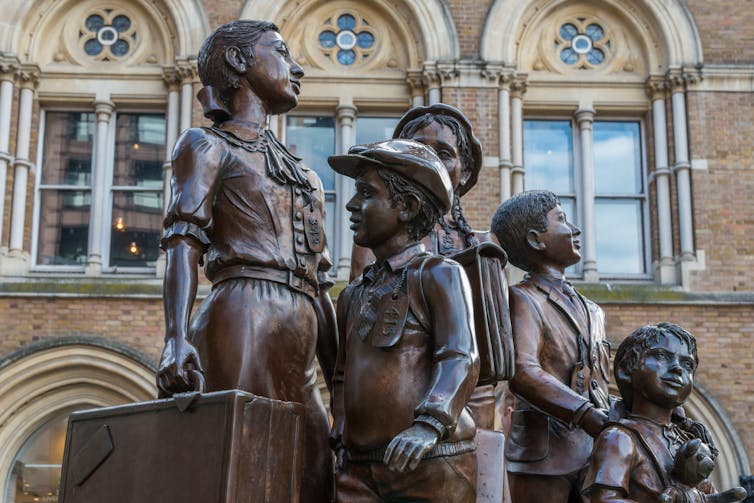Etifeddiaeth gymhleth 'Kindertransport': achub plant rhag y Natsïaid tra'n gadael eu teuluoedd ar ôl

Credit - Archivio UDI Bo
30 Tachwedd 2023
Mewn erthygl yn The Conversation, mae Dr Andrea Hammel o'r Adran Ieithoedd Modern yn trafod etifeddiaeth gymhleth 'Kindertransport'.
When 200 unaccompanied child refugees arrived in Harwich, Essex, in early December 1938, they did so through a new visa-waiver scheme. These children from Berlin were escaping Nazi persecution, and eventually more than 10,000 children – mostly from Jewish families – would arrive in Britain via the same process.
December 2 marks the 85th commemoration of the Kindertransport. And compared to some of today’s anti-refugee rhetoric, the scheme looks like a successful official rescue mission. But is that true?
November 9 and 10 1938 saw state-sponsored violence perpetrated against Jewish citizens across the German Reich. The British government was subsequently put under pressure from the public to help continental Jewish citizens.
But prime minister Neville Chamberlain’s government was reluctant to offer refuge to Jews, fearing for the UK’s security, the cost and the anti-foreign and antisemitic sentiments of some of the electorate. So, it came up with the compromise of only admitting unaccompanied children rather than whole families. Chamberlain also refused to commit governmental financial or organisational help, saying:
The number of refugees which Great Britain can agree to admit … is limited by the capacity of the voluntary organisations dealing with the refugee problem to undertake the responsibility for selecting, receiving and maintaining a further number of refugees.
To only admit the children but not their families, is clearly one of the most controversial aspects of the Kindertransport. Some experts have suggested that parting from your own children was seen as more normal in the 1930s. However, home secretary Samuel Hoare that year discussed the pain that the parents were likely to experience when parting from their children:
I could not help thinking what a terrible dilemma it was to the Jewish parents in Germany to have to choose between sending their children to a foreign country, into the unknown, and continuing to live in the terrible conditions to which they are now reduced in Germany.
Without a doubt, it would have been better for all if the UK had admitted parents as well as children. My own research has shown that child refugees were adversely affected by this separation.
Kindertransport refugee Eva Mosbacher was a well-adjusted 12-year-old from Nuremberg who settled in successfully with her carers in Cambridge. Nevertheless, she continuously expressed her longing to be reunited with her birth parents in her letters. In 1942, her parents were deported with 1000 other Jews and murdered in the Belzyce ghetto in Poland. After the war, Eva stayed in the UK and worked as a nurse, but sadly took her own life in 1963.
The fact that the UK government did not financially and organisationally support the Kindertransport had undesirable consequences. Some MPs expressed the view that only those children who would be of benefit to the UK should be admitted.

This was reflected in the selection criteria of the refugee children’s committee, an interdenominational umbrella organisation based in the UK and tasked with overseeing the Kindertransport. Largely staffed by volunteers, it tried to only admit children who did not have any special needs or health issues. This seems especially cruel as by 1938, many of youngsters had lived under the stressful conditions of discrimination and persecution for years.
The refugee children’s committee also rejected applications if any illnesses or additional needs were mentioned. Even children whose parents had mental health problems were rejected. Born on April 26 1926, Herta Baumfeld was not accepted for the Kindertransport because her mother was in a psychiatric institution. Herta was subsequently murdered at the Maly Trostinec concentration camp in Belarus on September 18 1942.
Financing the escape of the child refugees and their resettlement in the UK was especially difficult without the help of the UK government. In fact, the government demanded that a “guarantee” of £50 per child was raised by volunteers to indemnify against any expense. This rule limited the number of children that could be given refuge.
What made the Kindertransport possible?
The Kindertransport happened because of the generosity and commitment of private citizens, charities and voluntary organisations in the UK. The majority of refugees were fostered by individual families who volunteered for the task.
Furthermore, the financial burden was shouldered by private sources. Former Prime minister Lord Baldwin had launched a public appeal raising more than £500,000 and the Anglo-Jewish community raised more than £5 million for refugees.
Some foster carers also managed to raise the £50 guarantee themselves. As my research shows, Lia Blum from Czechoslovakia was fostered by a teacher from Ynys Mȏn, north Wales, who put up the guarantee.
Others helped within their means. For example, the guarantee for Anneliese Adler was raised by the Woodcraft Folk, a youth-led organisation for children and young people in Tooting, London. Anneliese was fostered by a woman near Bristol. However, the limited funds restricted the number of children that could be rescued.
Reliance on volunteers
In recent years, the UK government has once again relied on the support of volunteers to look after refugees. Following the refugee crisis of 2015, it launched the community sponsorship scheme, which relied on volunteers to raise £4500 per adult they wished to sponsor.
And after the invasion of Ukraine by Russia in 2022, the UK government once again looked for volunteer hosts via the homes for Ukraine scheme.
Given what happened 85 years ago, it’s time we learned the lessons of the past and created a stable government scheme to assist refugees of all ages.![]()
Mae'r erthygl hon wedi ei hailgyhoeddi o The Conversation dan drwydded Creative Commons. Darllenwch yr erthygl wreiddiol.



